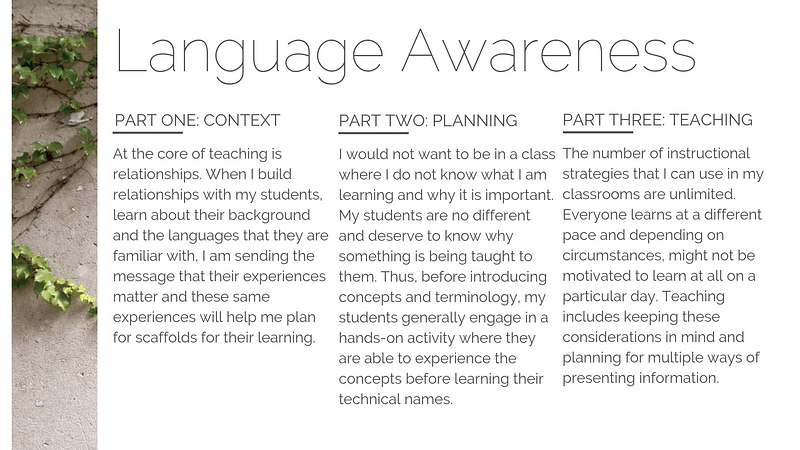Education must shift from instruction, from the imposing of stencils on brain pens, as it were, to discovery — to probing and exploring and to the recognition of the language of forms.
Marshall McLuhan
The two images that this quote conjures are starkly different. The first image from “imposing of stencils on brain pens” is that of students sitting in a classroom, listening to the teacher or blankly starring at her while the teacher goes about her duties — teaching them the curriculum. The second image that comes to mind when I read “probing and exploring” is that of the students working in groups, problem-solving while the teacher circulates around the classroom, offering advice and suggestions wherever needed. The first mental image is from my school days and the second one is of my future classroom.

“imposing of stencils on brain pens” ; Photo by JESHOOTS.COM on Unsplash 
“probing and exploring”;
Photo by Markus Spiske on Unsplash
I believe that the “language of forms” that McLuhan mentions in the quote refers to the many ways and tools that we use to impart knowledge to our students and that the way we teach emphasizes not only what we value but also how much we value something. For example, “imposing of stencils on brain pens” implies an emphasis on repetition and memorization while “probing and exploring” makes me think of the freedom to pursue curiosities. If I always give a lecture, I do not have to say that I value memorization and do not care about student understanding; it is implied in the actions that I do. Similarly, I do not have to announce to a class that I want them to probe and explore — just giving them the opportunity is enough for them to be explorers without explicitly stating it.
The intent behind every action is important and changes the way it might be perceived. Since we use language, whether spoken or non-verbal, to communicate with our learners, my focus for this article will be developing my language awareness and how that relates to the quote and the medium being the message.
My role in language awareness and meaning
The Association for Language Awareness defines language awareness as:
explicit knowledge about language, and conscious perception and sensitivity in language learning, language teaching and language use.
Association for Language Awareness, 2015
As a teacher, I not only need to know the language of instruction and the academic language of my subject but also need to be aware of strategies to integrate these languages in my instruction such that all of my learners, especially those from culturally and linguistically diverse backgrounds can understand and use them. There are two types of languages that I will use in my classroom: the conversational language which consists of day-to-day conversations, gestures and facial expressions, sometimes referred to as BICS (basic interpersonal communication skills), and academic language which will be particular to the subject that I will be teaching, also known as CALP (Cognitive Academic Language Proficiency).
Language as the Medium and the Message
The Cambridge Assessment International Centre is a great resource to understand language awareness better and integrate it into the teaching practices. Here are six areas they suggest to focus on for language awareness.


These six areas form a useful framework to work with, as I work on my language awareness and the messages that I am giving to students. For example, by planning hands-on activities in my lessons, I am building context. Rather than imposing ideas on my students, they are able to build their own ideas. With regards to teaching, I use videos in my lessons because they have captions that can be helpful to my English Language Learners, who might not be able to catch some terms easily or might find it easier to read text and follow along that way, and those who need accessibility support. In their own time, students can also go back to the videos and rewatch them at a speed that suits them.
These little accommodations go a long way because technical terms, in particular, are hard to catch the first time. I also highlight my notes packages for definitions to be easily found, encourage the depiction of concepts in flow charts and mind maps, I am always working with my students to give them different ways to see the concepts.
In assessments, Exit Slips are the little notes that give me ideas to incorporate in my future lessons and search for ways to meet their needs better. The fact that I am taking action based on their responses shows them that I care and that I am not collecting information for the sake of documentation. The actions are the message and the medium. These notes also lead to reflection which allows me to think about my actions as well as motivates me to make changes to my instructional practices. I keep a checklist of the students that I checked in with at some point in the class and hopefully I did not miss anyone.
By collaborating with other teachers, the students get the message that their teachers work together to support their learning and are not afraid to ask for help.
Some Examples for Language Awareness from the Math Classroom

In the Math classroom, there are three representations of knowledge — concrete, pictorial, and symbolic. Thus, before teaching the mathematical expressions, students should be given the opportunity to play with physical manipulatives, draw pictures of the relationships that they are seeing and then express them in mathematical terms. This relates to language awareness as well because students are slowly moving from BICS to CALP, seeing their knowledge in progress in real time. The three representations act as scaffolds for one another because from concrete objects, we can draw pictures and from pictures we can identify pattern.
These three mediums give the message that Math is not about filling sheets of papers with question — it is about exploration and patterns and is found in our everyday life.
A beautiful example presented in Clifford & Friesen (1993) was that of time. If I am teaching about time and I have students who use different languages at home, this is a great opportunity to ask them how they say the time in their language. As humans, we are always curious about how to say something in another language. In the secondary Math classroom, we can also explore the history of geometric figures, bring in mathematical instruments that might be used in other cultures, continuing to build our curriculum as well as community knowledge. This not only provides context to those who are unfamiliar with these concepts, it also welcomes them to share their own stories that might be related and ask any burning questions that they might have.

My examples in the Math classroom are often derived from activities that students like. For example, if we are learning about functions, an activity that I use is that of a ferris wheel. Students are given thread and cardboard to create a ferris wheel and simulate its motion. Some of them might not want to engage in this craftwork, so they have access to Geogebra where they can see the simulation of a ferris wheel at work. We then together explore the motions of the ferris wheel and come up with expressions for it, looking for the numerous relationships that exist there. This activity is inspired by Johnston, Hornbein & Azeem (2007).
Conclusion
Marshall McLuhan’s quote is a reminder of the responsibility I have towards my 21st century learners — I am their guide. The way I teach my students and interact with them, gives them the message about how much I care about them. Giving them autonomy empowers them and encourages them while in the old days, there was no autonomy and we were working in the factory system, as explained in Ken Robinson’s famous video, Changing Education Paradigms.
The need for instruction and introducing concepts to students has not diminished. However, what has changed in education is the fact that we use multiple ways to allow students to build their own knowledge. We do not impose stencils on their brains, instead we let them develop their brains in the way that works best for them.
References
Boaler, J. (2015). Mathematical mindsets: Unleashing students’ potential through creative math, inspiring messages and innovative teaching. John Wiley & Sons.
Clifford, P. & Friesen, S.L. (1993). A Curious Plan: Managing on the Twelfth. Harvard Educational Review, 63(3): 339–358.
Friesen, S., & Jardine, D. (2009). 21st century learning and learners. Prepared for Western and Northern Canadian Curriculum Protocol by Galileo Educational Network.
Johnson, H. L., Hornbein, P., & Azeem, S. (2017). Investigating functions with a ferris wheel. Mathematics Teacher, 110(5), 344–351. Retrieved from jstor.org

Be First to Comment